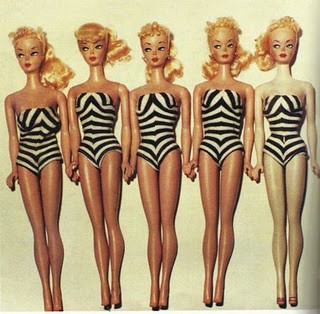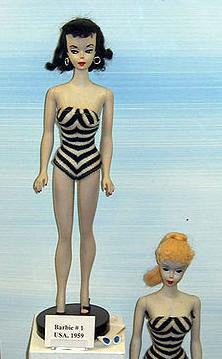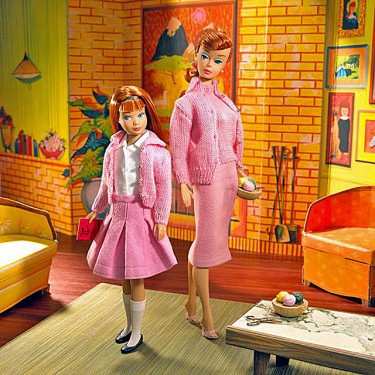Story Has Everything You Want in a Story

Oh yes: this is the story that has it all, baby: Four Loko, insurance scams, foreclosures, a retired ladies detective club, RICO complaints, fake absentee ballots, the FBI, Las Vegas, offshore bank accounts and actual broken kneecaps. Stick with it, it gets crazier and crazier.
Store Open
In a poignant demonstration of how the emptiness at the center of American life has resulted in a yearning so desperate for any kind of connection with which to fill that gaping void, a whole bunch of people showed up early today at the train station for the opening of an electronics store.
Women Good At Criticism

I would like to pitch some kind of “Bosom Buddies”-type sitcom in which Time television critic James Poniewozik is forced to don drag in order to ply his trade because since we started letting ladies write about the tube, it turns out that they are pretty solid. Probably better than dudes, even. Maybe next we’ll let them write about politics and stuff! Or am I just being crazy? Anyway, Awl pals abound in this one, so give it a look.
Photo by Ronen, via Shutterstock
Moon Pics
Here are a series of pictures in which people appear to be doing things to the moon. Sadly, none of those things are pounding it in the dark side with such ferocity and single-minded intensity that it crumples into a corner and begs for more because it has finally realized that you are right about it being a totally worthless satellite that is not even good enough for reflective light purposes and it can only find any degree of validation and self-esteem through your firm and vigorous ministrations. But the one where it looks like someone is playing basketball with it is pretty cool. [Via]
Why Is the EPA Putting Poison in America's Water?

According to Senator James Inhofe, the EPA, at Barack Obama’s bidding, has finally released a draft report on some wells in Wyoming that is obviously full of lies. For one thing, he stingingly calls the draft report “a draft.” Oooh, burn! It’s hard to believe the EPA has the chutzpah to disguise what is a clearly labeled draft report as a draft! It’s also “political science,” and, according to the local fracking companies, the EPA introduced chemicals into the local water that are the same chemicals that fracking utilizes. Do you see how sneaky the EPA is? They figure out what’s in the secret fracking cocktail, and then spread that stuff around and make U.S. citizens drink it. It’s the perfect plan. Anyway, there’s no motivation for the fracking companies to lie or to play political science, as we know, so I guess we just have to dismantle those crooks at the EPA.
"How can anything go bad when... there are so many funny things to tweet?"
Xeni Jardin’s writing about her breast cancer diagnosis this week is rough going but very much worth reading. But don’t dive in until you’re ready.
Two Poems By Sam Donsky
by Mark Bibbins, Editor
Midnight in Paris
Here in Paris the wind is dragging
us through the nervousness of what
money means. Women’s clothing,
manic repositories of seasons,
Satan, expatriate Manhattan,
art!, a sculptural exile into which
The Great Bras fall. We’re coming
on & as cosmos; each phone call
gothic & frock-coated — it’s
becoming so the metaphors
are more on the mark than
we’d prefer. (A brief sub-poem
about American Ex-Boyfriends:
Can anything be done / To stop
them? / Were their apologies /
Not honestly the best in the
world? / Owen’s Oxford opens /
Like an alternate entrance. /
Sixty years from now / Even
our chests will be long gone.)
Threat of rain, see-through-shirt
Test Ban Treaty, hierarchy
of bangs since the one
in the books. Art means saying
“here we go!” a lot; money means
not carrying an umbrella
sometimes. These are the things
that will deliver us from zero.
Texture of midnight, day of
rest, pageant for the change
you wish to see in these
clothes. Paris: “I have
done something terrible” —
this weather is the last art
lesson we may ever need.
Evidence suggests beauty
looks guilty even from the moon.
Bridesmaids
Our proposals cling their
paradise to the sides of
themselves nearest Mars.
Pickup line, dive bar, the
emperor’s new, comma,
charm: “I love you like a
math solution to an
insurance problem.” We
get divorced every time.
Men are from accuracy;
women, precision — none
of those poems actually
turn out to be true.
Elliptical motion,
smattering of unfinished
children, 8-Ball-Shaking
Fellowship at the School
of Brass Rings: the newer
tenses tend to play by less
than phonological rules.
Sake-of-sleep anomaly;
drunken groped analytic:
If there’s a will there’s
a nostalgia for it. If one
must say “Marry me”
in one’s twenties
one must prepare
to hear “We’re born
not knowing language”
in return. Non-terminal
symbols, string
of dispossessed beers:
the hours that are the
answers between the
minutes & me. One must
have a stake in one’s
standards’ traits
beyond their perfection.
“I love you like a good
semantic tailspin.”
We speak now &
mostly hold our peace.
Sam Donsky is a graduate student living in Philadelphia. The poems come from his nearly finished first manuscript, Poems vs. The Volcano, a collection of 100 poems for 100 films.
For poems galore and so much more come on down to the Poetry Store. Which is what we call The Poetry Section’s vast archive! “The Poetry Store.” Adorable, right? Anyway, there sure are a bunch more poems in there.
You may contact the editor at poems@theawl.com.
Records Enjoyed
Awl pal Alex Ross gets listy, picking his ten favorite classical recordings of the year. There is some supplementary material here.
Squirrel Mischievous
Try as she might, even someone as skilled at the wacky animal beat as Dara Brown is cannot sell a terrible line like “No word if the squirrel will be getting detention” with any degree of authority. It’s just a bad line. Anyway, check out that squirrel! He totally set off that fire alarm!
How Much More Do Barbies Cost Today?
How Much More Do Barbies Cost Today?

It’s gift-buying time, for whichever ecclesiastical reason you personally buy your gifts. So here’s a nifty trick question for the daughters/nieces in your life after they’ve opened their presents: how old would Barbie be in real life? The easy answer is that she would be 52, as she was introduced in 1959. But not so! She was introduced as a teenager, of course (let’s say sixteen), so the actual year of her birth would be 1943. And do you know who else was born in 1943, do ya? This guy.
Oh, that should be a good one.
But if you are shopping for young kids of a certain age, chances are you will be buying a Barbie. After all, three or four generations have grown up with Barbie as a go-to Christmas present. Surely the passage of time has not affected the base price of the Barbie as it has other things favored by children? I guess we should find out.

In case you are one of those Americans who take Barbie for granted, the success story frequently reported as the triumph of the imagination of Barbie’s creators is actually more the success story of the company they founded a decade before they introduced Barbie, Mattel. Mattel’s founders, Ruth and Elliot Handler, started in 1945, working out of a garage workshop. In 1959, they launched Barbie, which Ruth named after her daughter, who inspired the product with her fascination with paper dolls with cut-out outfits. This Barbie was a little more frightening looking than the one you’re used to, heavy on the eyeliner, with a wicked widow’s peak and a permanent sidelong glance. She originally sold for $2.99 (which, converting into 2011 dollars with this handy app, equals $23.26), and she flew the shelves, putting Mattel on the map as a toy industry behemoth (which would go on to produce such iconic toys as Chatty Cathy and Hot Wheels, and eventually acquire Fisher-Price).
Barbie didn’t exactly reinvent dolls — both Ginny dolls and Madame Alexander’s high-fashion Cissy dolls were competitors of Barbie at the time of her launch — but no one today is having
over a hundred plastic surgeries to look like Ginny or Cissy, at least.
Part of the intended appeal of the doll was that she was a clotheshorse, and as such, different outfits could be purchased in which to dress her up. We’re leaving the outfits out for the purposes of price comparison, but we note them for the purposes of gawking, such as this designer pink gown available in 1975 (for $3.99, or $16.79 in 2011 dollars), or this 1965 collection of elegant eveningwear, from prom dresses to mink stoles, starting at $2.43 each (or $17.47 adjusted).

Barbie was not just a heavily accessorized doll; Barbie was a narrative. She was initially introduced as a “shapely teenage fashion model,” but as sales took off, Barbie’s story filled out. By 1961 she had a boyfriend, Ken, and by 1964 she had a little sister, Skipper, selling for $1.91 (or $13.95, in 2011 dollars). As years progressed, the storyline filled out with more characters and a ceaseless array of accessories, like houses and cars, and playsets denoting the activities filling the Barbie lifestyle, recreational and even occupational. Barbie’s age was elastic as well — she could be played out as a late-teen college student, or a fully grown-up TV game show hostess, only $11.99 in 1988 ($22.95 in 2011). Barbie’s enduring appeal is based on the fact that she is, and has been, simultaneously nostalgic and reflective of the current era.
Special mention must be made of Barbie’s domicile, which wasn’t just a house but a Dream House. My little sister had one, and I don’t think there were many of her friends who didn’t have one as well. Their cost tended to be on the prohibitive side, but where else was Barbie going to sleep? In the toy chest? In 1992 you could get this one, a modest little three-story with furniture and accessories for $169.99 (or $274.34, adjusted).
Mattel kept Barbie changing with the times, toying with Barbies that reflected the current fashion (1969 Mod Fashion Ensembles, retailing from $1.99, or $12.28 adjusted), which was difficult during the Sixties, in light of the turbulence of the era — go-go boots for Barbie and a Nehru collar for Ken might make good fashion, but the potential to be identified with the more divisive aspects of the late Sixties and the Sexual Revolution (e.g., flag-burning, free-loving, etc.) made for a delicate path for Mattel. But in 1971 they hit a home run with Malibu Barbie. Malibu Barbies was not a post-Hippie Barbie, or even a pre-Kent State Barbie, but rather an eternally ageless beach bum Barbie. Mattel sidestepped the issues of reflecting the popular consensus by placing the Barbie in the context of a non-political, leisurely innocence. If you were a child of the ’70s, Malibu Barbies were as ubiquitous as Micronauts. When she rolled out in 1971, she retailed for $1.94, or $10.85 adjusted.
Even though Barbie has been a beloved children’s toy for decades, she became a polarizing topic as feminism grew in the 1960s. Foremost, Barbie is not shaped like a real person — her boobs are as impossibly big as her waist is impossibly tiny. It’s a creepy message to send to little girls (or big girls, for that matter). But even on a more subtle level, the assigned gender roles displayed by the Barbie of the time, be it the bobbie-soxer wife-in-training of the early ’60s or the young career girl seeking implicitly feminine occupations of the ’80s, there is a certain tension between What We Are Actually Telling Our Future Generations and What We Feel They Should Be Told (which I would paraphrase as, “You can be anything you want to be as your gender is not an obstacle, no matter what Barbie tells you.”)
This tension is pretty much impossible to dispel in a world so big, especially when issues of commerce are involved, but they did result notably (and amusingly) in the formation of the Barbie Liberation Organization, which, in 1993, switched the voice chips in three hundred Teen Talk Barbies with those from Talkin’ Duke G.I. Joe “action figures.” The Teen Talk Barbies were then under fire, as one of the pre-recorded phrases that the doll would speak was, “Math is hard.” Now, math is hard, of course, but out of a Barbie’s mouth it’s a horizon-limiting moment. Out of G.I. Joe’s mouth? Weary, existential observation. (Teen Talk Barbie, at the time of its release in 1992, retailed for about $25, or $40.35 adjusted) for Christmas.
Another unique entry into the Barbie line appeared in 1997 — Share A Smile Becky. Becky is the member of the Barbie universe in a wheelchair. Becky (and her rig) went for $22.99 at the time, or $32.43 adjusted. As a sad accidental bit of verisimilitude, as critics noted at the time, Becky’s wheelchair did not fit through the front door of Barbie’s Dream House. Also it’s uncertain if the intent of labeling Becky as “Share a Smile” was anything but politically correct condescension, though we sure did share a smile when my wife gag-gifted a Becky to her Barbie-mad mother some years ago (more of a share-a-shriek event).

There is an aspect of consumption that is aptly raised by this cursory examination of Barbie: the “secondary use market,” or the collectors market. If you take a quick spin around the web, you will see that Barbie is not only a very popular topic, with links popping up to all the retailers, but she is even more popular as a collectible, with a big messy underworld of those who collect Barbies and those who sell things to them. This is not unique to Barbie, of course, if you have ever collected baseball cards or comic books, but it is robust. Eventually Mattel recognized this market and began to manufacture lines of Barbies aimed at the enthusiast as opposed to the child, the Limited Edition line and the Collector’s line, with dolls based on iconic movie stars or characters, or wearing clothes specially designed for the doll by name designers.
For example, take the Punk Rock Barbie (more accurately, the tokidoki Barbie), designed by Simone Legno as part of the Collector line, with an off-the-shoulder heart and crossbones T and a very grown-up collection of tats, which is currently available for $50, and which has caused a bit of a stir, as she is seemingly styled in a fashion perhaps less than appropriate. (Definitions of appropriate may vary, of course.)
But if you’re in a rush, and you can navigate the bewildering number of options available (collectors editions of everything from I Love Lucy to Farah Fawcett Poster to Twilight), you can pick up a simple Beach Barbie for $6.99 from Target. Not bad. Or go big and add on the Barbie Dream House from Amazon, for $159.99.
So how has the cost of a Barbie, translated into 2011 dollars, changed over time? (Note that actual dolls are in bold, and accessories are in italics.)
1959 — Barbie Fashion Doll: $23.26
1964 — Skipper: $13.95
1965 — Eveningwear Ensemble: $17.47
1969 — Mod Fashion Ensemble: $12.28
1971 — Malibu Barbie: $10.85
1975 — Pink Gown Ensemble: $16.79
1988 — TV Game Show Set: $22.95
1992 — Teen Talk Barbie: $40.35
1997 — Share a Smile Becky: $32.43
2011 — Beach Barbie: $6.99
2011 — tokidoki Barbie: $50
Confusing! As you can see, even if you ignore accessories, the prices jump all over the place. True, the lowest price item is the most recent, basic no-frills doll, which, at $6.99, represents a steep drop from the 1959 version. But even as the baseline decreases over time, there is the alternate universe of stuff staring you in the face without which the Barbie experience is incomplete.
And for those of you thinking about dabbling in real estate, check this:
1992 — Barbie’s Dream House: $274.34
2011 — Barbie’s Dream House: $159.00
It’s truly a buyer’s market in the world of Barbie real estate, though the Dream House remains a big-ticket item amongst the items you might find under the Christmas tree.
Give credit to Mattel: as Barbies became so overwhelmingly popular and the price of the basic dolls themselves decreased, they found innovative new ways for children to browbeat their parents into doling out massive amounts of money to them. As a one-time child (that reference to Micronauts was not an accident, no, and the Batmans and Green Arrows I played with were called super hero dolls around the house and not action figures), I totally understand, and as an adult of child-rearing age, I’m terrified.
Related: When Barbie Came To Live With Us
Brent Cox is all over the Internet.
Photo of first edition Barbies by Сергей Бережной, via Wikipedia; image of Barbie and Skipper courtesy of James Vaughan, via Flickr.
